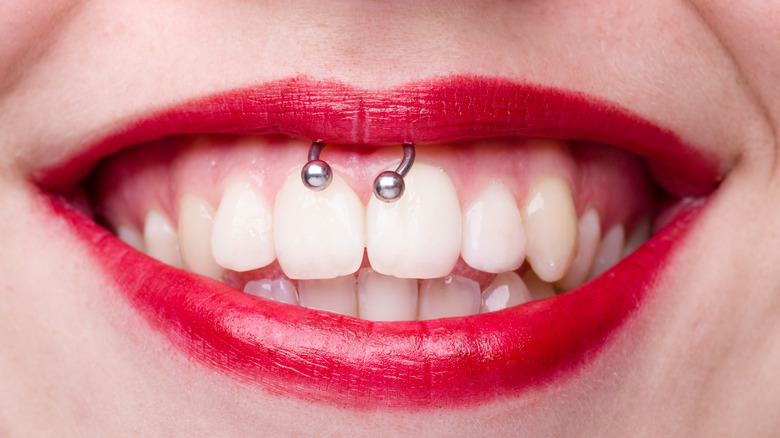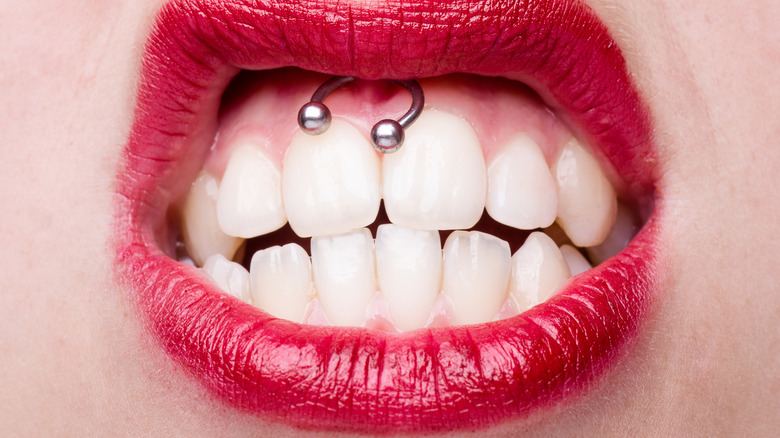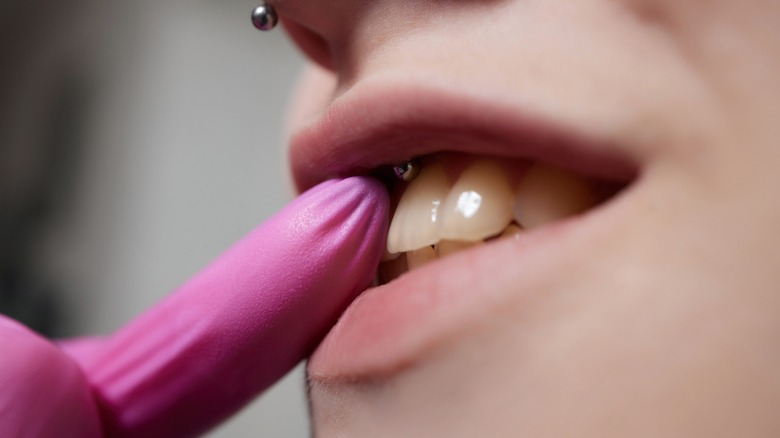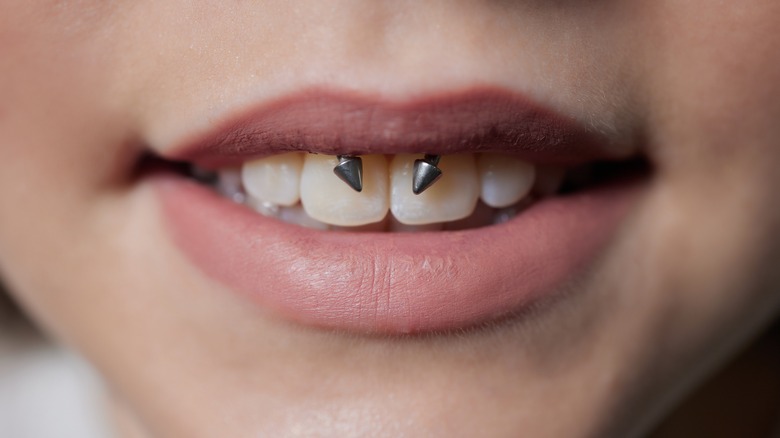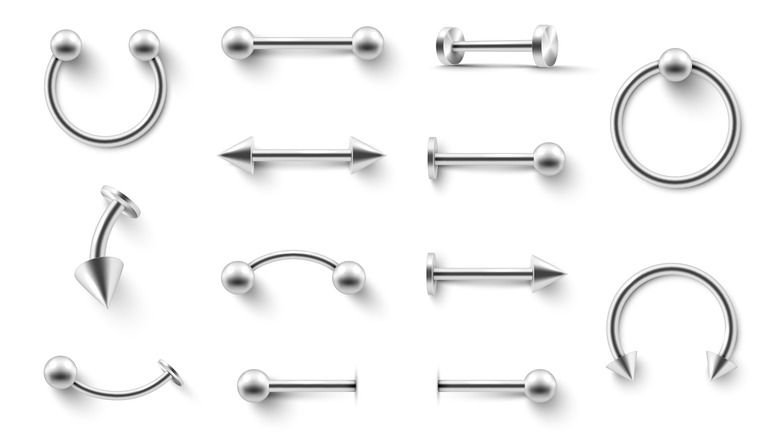Our Guide To Smiley Piercings (& The Risks Involved In Getting One)
There's nothing like a fresh piercing to give yourself a sense of reinvention. If you're looking to add a new layer to your style, you can invest in a unique piercing to seamlessly level up your everyday look. Of course, if you're the type to get a new piercing when you're feeling bored, you may be running out of new locations. Enter the smiley piercing.
This trendy piercing placement is nothing new. The style was seen in magazines as early as the 1990s and could've been around earlier! After all, one of the benefits of the smiley piercing is that it's subtle and easy to disguise. Who's to say that Laura Ingalls wasn't rocking one on the prairie?
Body modifications shouldn't be taken lightly. If you're considering a smiley piercing, you may have many questions. Fortunately, we have all the answers you need to decide whether or not this type of piercing is something to smile about.
A smiley piercing goes through your lip frenulum
The name "smiley piercing" gives you some clues as to where on the body it is located. If you guessed lip or tongue piercing, you're getting close. If "lip frenulum" piercing came to mind, congratulations on knowing the scientific terminology or reading the heading of this segment.
Don't let the word "lip" confuse you, though. The frenulum isn't really part of your lip. Instead, WebMD defines it as a small piece of tissue that keeps your upper lip attached to your gums. A smiley piercing goes those either side of this tissue piece, rooting the jewelry behind your lips. The name "smiley" is derived less from its actual position but from the piercing being typically only visible when you raise your lips in a smile.
If this happy-go-lucky piercing is an obvious choice for your next body mod, you may want to pump the breaks temporarily. Piercings come with inherent risks, and the smiley piercing is no different.
Risks of a smiley piercing
If you've pierced your ears, you may feel as though you know the risks of the process. We've all heard the lectures about cleaning and infection — how hard could applying those lessons to a new piercing be? Unfortunately, some of the piercings' inherent risks are exacerbated by the smiley's location. The American Dental Association warns that mouth piercings can be especially prone to infection due to the high quantities of bacteria in your mouth. And, as you might know from a neglected ear piercing, infections can cause swelling. The last thing you want is swelling near your airways.
Colgate also notes that you don't want to leave your piercing unattended in your mouth for too long. Ignoring discomfort or swelling could lead to the jewelry becoming embedded and requiring surgery. If you feel the installation rubbing against areas of your teeth and gums, that's a warning sign. Over time, you could irritate or rub away tissue.
In the interest of full disclosure, you should also know that Twitter is home to a few horror stories. "I swallowed my smiley piercing," one user wrote. Another had a similar experience with a slightly happier ending. "I just swallowed my smiley piercing," they wrote. "Then coughed it back up."
Smiley piercing pain and recovery
You might feel a smiley piercing is right for your aesthetic but is it suitable for your pain tolerance? If you've had other piercings, you're well-equipped to handle the pain of a smiley piercing. Some sources, like Obsidian Piercing, even suggest that this placement is among the least painful due to the frenulum's lack of nerve endings. On the other hand, Healthline warns of possible discomfort as your small frenulum learns to support the new jewelry.
Despite its fragility and the high-risk placement in your mouth, the smiley piercing heals much quicker than cartilage or upper ear piercing. Comparable to an earlobe piercing, smiley piercings take between 4 to 12 weeks to heal, according to WebMD. Of course, this timeline can be lengthened with complications like infection or piercing rejection. For this reason, it is essential to closely follow the care instructions after the procedure.
Caring for a smiley piercing
Caring for your smiley piercing is a crucial part of rocking this trendy look. Many of the biggest recommendations for taking care of your piercings may already be a part of your daily routine. For example, brushing your teeth and flossing can help to eliminate harmful bacteria that may be residing in your mouth and go after your fresh piercing. Healthline does note, however, that there are a few adjustments you'll need to make. Opt for an alcohol-free mouthwash, or use sea salt or saline solution for rinsing your mouth. You may also want to switch to a more mild toothpaste flavor, as strong mints may serve as irritants.
And, though your tongue may have trouble getting used to the new mouth addition, you'll want to avoid fiddling with your fresh piercing as much as possible. Frequently poking it with your finger or tongue can delay the healing process.
Who can get smiley piercings?
Due to the risks associated with inner-mouth piercings, many places will only give smileys to adults. You should check the age requirements your piercer has set and be prepared to present your ID.
Outside of age, a few factors may prevent you from getting a smiley piercing. Lip frenulums naturally come in all shapes and sizes, and if you have a smaller attachment, there may not be adequate room for you to get it pierced safely. Smiley piercings don't coexist well with many other metals in your mouth. If you currently have braces, waiting until you complete orthodontic treatment is wise. Interestingly, Healthline also identified some hobbies that could interfere with a smiley piercing, such as playing a musical instrument that disrupts the pierced area of your mouth.
Finally, you may want to consider your mouth shape before investing in a smiley piercing. If you don't see much of your upper gums when you smile in the mirror, you may be disappointed by how hidden your smiley piercing will be. One Twitter user lamented her experience with this, writing, "i got my smiley piercing yesterday just to take it out this morning [be]cause i realized ian [I don't] like it anymore, like you can't even see it when i smile."
Cost of a smiley piercing
The cost of a smiley piercing typically ranges between $30 and $90, depending on where you go. Due to the high-risk placement of the piercing and the precision it requires, it may be worth paying extra for a highly experienced practitioner with the best tools.
Over time, a smiley piercing may have more maintenance costs than a typical piercing. Smiley piercings should be viewed as only semi-permanent due to their volatile position. Frenulums that are big enough for a smiley piercing is still small overall and can't be expected to support the jewelry forever. Because our mouths are constantly in motion, you may eventually notice that your piercing is "rejected."
One final cost to consider is the price of the smiley jewelry itself. Because this is an inner-mouth piercing, you'll want to be extra cautious of the materials used in your piece. Lower-quality products risk wear, ingestion, and infection — so you'll want to splurge for the best you can get.
Types of smiley piercings
The placement and structure of smiley piercings are relatively uniform across all styles. Still, there are many different types of jewelry that can be used to best express your aesthetic. The most common smiley piercing shape resembles a frown, consisting of a barbell shape with beads on either end. With this option, you can achieve the look of having a double-decker septum piercing and show off those bottom beads when you smile.
However, like septum piercings, you can also use your frenulum to show off a ring or a completed loop style. It is worth noting, however, that some sources report pain varying depending on the piercing shape you select. If this is a big concern for you, be sure to discuss your options with your piercing professional.
Finally, you can get very creative with your smiley jewelry. If you've ever admired someone's mouth piercing that made it appear like they had fangs, they likely wore a stylized bar through their frenulum.
Smiling piercing materials
As mentioned, choosing the right material for your smiley piercing is essential for its health and longevity. Even if you have no history of sensitive skin or infected piercings, the bacteria biome of your mouth introduces entirely new challenges to your jewelry. Dentalcare.com recommends different materials for the various stages of your healing process.
Seek implant-grade stainless steel, titanium, or niobium for your initial piercing. After things have healed, you can move on to piercings containing at least 14 karats of gold or other high-quality materials like platinum. For a more affordable option, you can even wear non-reactive plastics like Tygon or Teflon — but avoid gold plating or other decorative materials that could wear off and be ingested.
You might not normally seek the highest-quality jewelry, but cheaper materials like plastic or acrylic can grow and house bacteria more easily. They shouldn't serve as your go-to or long-term pieces.
Alternative types of mouth piercings
If you're not sold on the smiley, there are still many other piercing options that can help freshen up your style. Many of the care instructions you now know for smiley piercings apply to all inner-mouth piercings, so you're perfectly prepared to try out a different spot.
To begin with, smiley piercings aren't the only kind of frenulum adornment. You can also pierce the connective tissue between your gums and bottom lip, appropriately called a "frowney piercing." You also have a frenulum connecting your tongue to the floor of your mouth.
The oral piercing category also encompasses lip piercings, tongue piercings, and cheek piercings. There are truly endless options for those hoping to get a new stud. As always, concerns about care and risk should be directed to your piercing professional before getting some new bling. The risks associated with mouth piercings are not negligible, and you are entitled to all the information you need to make an informed decision.
